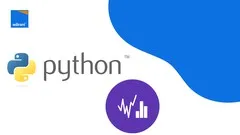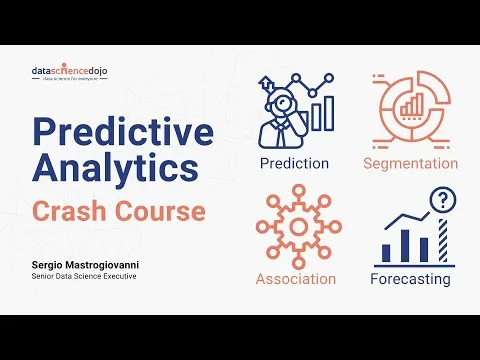
Making Numerical Predictions for Time Series Data - Part 1&3 
Learn how to make accurate predictions for time series data in this comprehensive course. Predictive analytics is a powerful tool that uses data mining, statistics, machine learning, and artificial intelligence to forecast future events. In this course, you will explore various techniques, starting with simple methods and progressing to advanced models. Using Excel, RProgramming, and Python, you will gain hands-on experience in making numerical predictions. With easy-to-understand exercises and real-world examples, this course is suitable for beginners and experienced professionals alike. Don't miss out on this opportunity to enhance your predictive analytics skills. Enroll now! ▼
ADVERTISEMENT
Course Feature
![]() Cost:
Cost:
Paid
![]() Provider:
Provider:
Udemy
![]() Certificate:
Certificate:
Paid Certification
![]() Language:
Language:
English
![]() Start Date:
Start Date:
2019-10-28
Course Overview
❗The content presented here is sourced directly from Udemy platform. For comprehensive course details, including enrollment information, simply click on the 'Go to class' link on our website.
Updated in [September 15th, 2023]
What does this course tell?
(Please note that the following overview content is from the original platform)
Predictive analytics is the branch of the advanced analytics which is used to make predictions about unknown future events Predictive analytics uses many techniques from data mining statistics modelling machine learning and artificial intelligence to analyse current data to make predictions about futureOne class of Predictive Analytics is to make prediction on Time Series Data Studying historical data collected over a period of time can help in building models using which future can be predicted For example from historical data on Temperatures in a City we can make decent predictions of what the Temperature could be in a future date Or for that matter from data collected over a reasonably long period of time regarding various life style aspects of a Diabetic patient we can predict what should be the volume of Insulin to inject on a given date in future One example to consider from the Business world could be to predict the Volume of In-Roamers in a Telecom Network in any given period of time in the future from the historical details of In-Roamers in the Network The applications are just innumerable as these are applicable in every sphere of business and lifeIn this course we go through various aspects of building Predictive Analytics Models We start with simple techniques and gradually study very advanced and contemporary techniques We cover using Descriptive Statistics Moving Averages Regressions Machine Learning and Neural NetworksThis course is a series of 3 partsIn Part 1 we use Excel to make Numerical Predictions from Time Series DataWe start by using Excel for 2 reasonsExcel is easy use and thus we can understand complex concepts through exercises that are easy to replicate and thus become easy to understandExcel is expected to be available with everyone taking this courseIn Part 2 we use RProgramming to make Numerical Predictions from Time Series DataIn Part 3 we use Python Programming to make Numerical Predictions from Time Series DataThe course uses simple data sets to explain the concepts and the theory aspects As we go through the various techniques we compare the various techniques We also understand the circumstances where a particular technique should be applied We will also use some publicly available data sets to apply the techniques that we will discuss in the courseFrom time to time we will add bonus videos of our real time work on industrial data on which we will apply the Predictive Analytics techniques to create Models for making predictions
We consider the value of this course from multiple aspects, and finally summarize it for you from three aspects: personal skills, career development, and further study:
(Kindly be aware that our content is optimized by AI tools while also undergoing moderation carefully from our editorial staff.)
What skills and knowledge will you acquire during this course?
During this course, the learner will acquire various skills and knowledge related to making numerical predictions for time series data. They will learn about the field of predictive analytics and its applications in making predictions about unknown future events. The course will cover techniques from data mining, statistics modeling, machine learning, and artificial intelligence to analyze current data and make predictions about the future.
The learner will specifically focus on making predictions on time series data by studying historical data collected over a period of time. They will learn how to build models using this historical data to make predictions about future events. For example, they will learn how to predict future temperatures in a city based on historical temperature data or how to predict the volume of insulin to inject for a diabetic patient based on lifestyle data.
The course will cover various techniques starting from simple ones such as descriptive statistics and moving averages to more advanced and contemporary techniques such as regressions, machine learning, and neural networks. The learner will also learn how to use Excel, R programming, and Python programming to make numerical predictions from time series data.
Throughout the course, the learner will work with simple data sets to understand the concepts and theory aspects. They will compare different techniques and learn when to apply a particular technique based on the circumstances. Additionally, the course will include bonus videos of real-time work on industrial data, where the learner will apply predictive analytics techniques to create models for making predictions.
How does this course contribute to professional growth?
This course on Making Numerical Predictions for Time Series Data - Part 1&3 contributes significantly to professional growth. By studying and applying predictive analytics techniques, individuals can enhance their skills in data mining, statistical modeling, machine learning, and artificial intelligence. These skills are highly sought after in various industries and can open up new career opportunities.
The course focuses on building predictive analytics models using historical data, which is a valuable skill in making predictions about future events. For example, individuals can learn how to predict future temperatures in a city based on historical temperature data or determine the volume of insulin to inject for a diabetic patient based on lifestyle data. These skills are applicable in numerous fields, including business, healthcare, and telecommunications.
The course covers a range of techniques, starting from simple ones like descriptive statistics and moving averages to more advanced techniques like regressions, machine learning, and neural networks. By understanding and applying these techniques, individuals can gain a comprehensive understanding of predictive analytics and its practical applications.
Moreover, the course provides hands-on exercises using Excel, RProgramming, and Python programming, which are widely used tools in the industry. By working with these tools, individuals can develop practical skills that are directly applicable to real-world scenarios.
Additionally, the course offers the opportunity to compare different techniques and understand when to apply each one. This critical thinking and decision-making aspect is crucial for professionals working with predictive analytics, as it allows them to choose the most appropriate technique for a given situation.
Furthermore, the course includes bonus videos showcasing real-time work on industrial data. This exposure to real-world applications of predictive analytics further enhances professional growth by providing practical insights and examples.
Overall, this course on Making Numerical Predictions for Time Series Data - Part 1&3 is highly beneficial for professional growth. It equips individuals with valuable skills in predictive analytics, enhances their understanding of various techniques, and provides hands-on experience with widely used tools. These skills and knowledge can significantly contribute to career advancement and open up new opportunities in the field.
Is this course suitable for preparing further education?
Yes, this course is suitable for preparing further education. It covers a range of topics related to predictive analytics, from descriptive statistics to machine learning and neural networks. It also provides practical exercises using Excel, R, and Python, which are essential skills for further education.
Course Syllabus
Introduction
Time Series Data
Moving Averages
Linear Regression
Exponential Regression
Power Regression
Logarithmic Regression
Non-Linear Regression
Selecting a Model
Bonus Videos
Closing Note
Course Provider

Provider Udemy's Stats at AZClass
Discussion and Reviews
0.0 (Based on 0 reviews)
Explore Similar Online Courses

Predictive Analytics: Introduction to Business Forecasting

Predictive Analytics on SAP Analytics Cloud

Python for Informatics: Exploring Information

Social Network Analysis

Introduction to Systematic Review and Meta-Analysis

The Analytics Edge

DCO042 - Python For Informatics

Causal Diagrams: Draw Your Assumptions Before Your Conclusions

Whole genome sequencing of bacterial genomes - tools and applications

Learning Predictive Analytics with Python

What is Predictive Analytics?


Start your review of Making Numerical Predictions for Time Series Data - Part 1&3